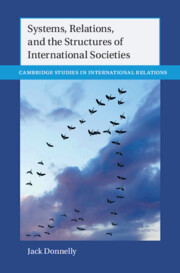Book contents
- Systems, Relations, and the Structures of International Societies
- Cambridge Studies in International Relations
- Systems, Relations, and the Structures of International Societies
- Copyright page
- Contents
- Figures
- Tables
- Acknowledgments
- Part I Systems, Relations, Levels, and Explanations
- Part II Waltzian Structural Theory
- Part III Systems, Relations, and Processes
- Part III (A) Differentiation and Continuous (Trans)Formation
- 10 Relations, Processes, and Systems
- 11 Multiple Dimensions of Differentiation in Assembled International Systems
- 12 Continuous (Trans)formation
- 13 Life Sciences and Social Sciences
- Part III (B) Four Excursions in Relational/Systemic IR
- References
- Index
- Cambridge Studies in International Relations
11 - Multiple Dimensions of Differentiation in Assembled International Systems
from Part III (A) - Differentiation and Continuous (Trans)Formation
Published online by Cambridge University Press: 19 October 2023
- Systems, Relations, and the Structures of International Societies
- Cambridge Studies in International Relations
- Systems, Relations, and the Structures of International Societies
- Copyright page
- Contents
- Figures
- Tables
- Acknowledgments
- Part I Systems, Relations, Levels, and Explanations
- Part II Waltzian Structural Theory
- Part III Systems, Relations, and Processes
- Part III (A) Differentiation and Continuous (Trans)Formation
- 10 Relations, Processes, and Systems
- 11 Multiple Dimensions of Differentiation in Assembled International Systems
- 12 Continuous (Trans)formation
- 13 Life Sciences and Social Sciences
- Part III (B) Four Excursions in Relational/Systemic IR
- References
- Index
- Cambridge Studies in International Relations
Summary
This chapter advocates viewing the structures of international political systems through the lens of multiple dimensions of social differentiation; the structured processes by which social actors and positions are produced, populated, related, reproduced, and transformed. Social differentiation involves, at minimum, establishing who has what authority over whom with respect to which activities; that is, differentiating actors, activities, and authorities (which usually are complexly interrelated). And in addition to institutional and normative dimensions, which are notoriously excluded from the Waltzian account of structure, social differentiation has important material or geo-technical dimensions that are also ignored in the Waltzian account (which is not, as is often claimed, materialist). More generally, I argue that rather than seek to identify a small number of structural models composed of a few elements, we should aim for a checklist of dimensions of differentiation that illuminate some recurrently important features of the structures of some social and political systems of interest.
Keywords
- Type
- Chapter
- Information
- Publisher: Cambridge University PressPrint publication year: 2023

